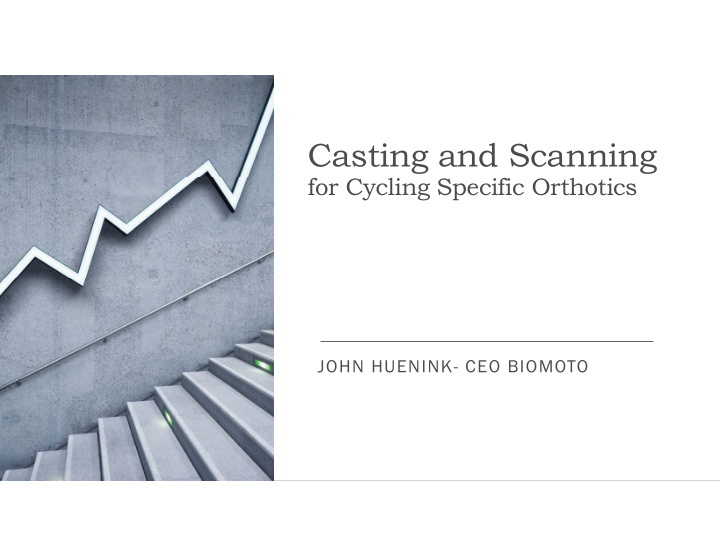



Casting and Scanning for Cycling Specific Orthotics JOHN HUENINK- CEO BIOMOTO
Biomechanical Corrections Utilizing the Sensory Motor System to Stabilize the Foot. MOVEMENT ANALYSIS AND CUSTOM INSOLE MANUFACTURING
Syllabus Custom orthosis and is it necessary? � What is Custom? � Is it an exact match of the foot captured in a cast- Static? � Enticing muscle function within the cycling shoe. � Ground based responses and compensatory movements. � Treatment of the foot not the shoe.
The Sensory Motor System � The sensorimotor system encompasses all of the sensory , motor , and central integration and processing components involved with maintaining joint homeostasis during bodily movements (functional joint stability). - Journal of Athletic Training � Utilizing gait analysis as a tool to see inside the cycling shoe. � Ambulatory sequences and dynamic patterns. � Identifying patterns and the corresponding corrections
Complex Movement Patterns The Gait Cycle: Initial contact- Loading Response- Mid Stance- Pre-swing- Initial swing- Mid swing- Mid stance- Terminal stance- Terminal Swing. Custom: Dissecting the possibilities in each component of gait and providing sequential solutions accordingly.
Heel strike- Foot Flat- Toe Off Let’s Simplify: � Is it necessary to understand every aspect of the foot and the biomechanical complexities to make an Insole for cycling? Not At All
The Capture What information is necessary: � Understanding basic foot deformities. � Basic video collection � Posterior view of 5 gait cycles (5 lefts or a total of 10 steps) � Anterior view of 5 gait cycles (the return) � Single leg squats (1 frontal and 1 lateral) 2 videos, 1 right and 1 left � A proper cast or scan of the foot.
Foot Deformities Dissection of the foot in color codes: � Forefoot – Midfoot- Hindfoot Foot Deformities: � Pronation – Neutral - Supination
Understanding the First Ray The Metatarsal Cuneiform Joint: � 1 st metatarsal � Cuneiform � Locking and unlocking of this joint � Plantarflexion of the 1 st Ray
The Foot as a Suspension Bridge The hindfoot as a neutral substructure: � A structural base Plantar flexion of the first ray: � The second structural base The midtarsals: � The arch
The Windlass Mechanism The “Locking” of the foot creating a rigid lever optimized during the propulsion phase of the gait cycle- The Push! The foot works in many planes Much like a door lock. When the tumblers align, we can turn the key.
Hindfoot Orientation- The Bike Proper orientation of the hindfoot promotes a neutral forefoot. In Relation to the Crank Arm: � Pronation � Neutral � Supination
Foot Point Diagram A simplified way to discuss the foot. � Designed by Jurgen Holterhus GMBH � For the practitioner � Pain P1, P6, P9 � For manufacturing � Increase P3, increase P9, decrease P9
Scanning of the foot Techniques in scanning: � Full weight bearing � Marking of the metatarsals � Location of the medial and lateral malleolus
Casting by foam box An inexpensive way to capture the foot. � Partial weight bearing to set the foot. � Pressing of the foot into foam. � Supporting hind foot and 1 st ray. � Have client stand, full weight bearing. � Send to lab with RX form and instructions. � Live Video demo
The Insole Standard Bedding insole: � Based on static capture Sensomotoric Insole: � Dynamic capture with custom influences.
Question and Answer Feel free to contact me with any question not addressed today. BIOMOTO John R Huenink 514B Wells St Delafield, WI 53018 john@biomotousa.com Office: 262-646-2422
Recommend
More recommend